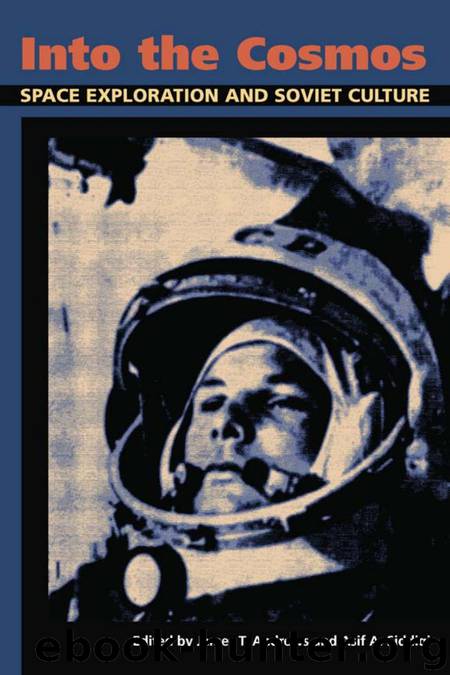Into the Cosmos by James T. Andrews & Asif A. Siddiqi

Author:James T. Andrews & Asif A. Siddiqi [Andrews, James T. & Siddiqi, Asif A.]
Language: eng
Format: epub
Published: 2014-08-17T00:44:48+00:00
Cosmic Enlightenment 179
Figure 7.1. Village planetarium lecture, Kharkiv region, Ukraine, in the early 1960s.
Source: Image courtesy of Kharkov Planetarium imeni Iu. A. Gagarina.
against the church.82 Positive measures, which grew in importance by
the late 1950s, entailed a campaign of mass enlightenment. In practice,
this meant a calling to arms of the “Knowledge” Society (Obshchestvo
“Znanie”), the primary Soviet institution charged with the development
of the new Communist citizen on the ground and, until 1964, the largest
institution involved in the theoretical development and practical applica-
tion of atheist education.83
Party cadres and intelligentsia enthusiasts were urged to form
local-level organizations (atheist clubs, Houses of Atheism, atheist de-
partments in educational institutions, and atheist sections in local party
organs, among others). These new institutions held atheist film screen-
ings, hosted debates, and question-and-answer sessions that brought
together believers and atheists, and staged atheist holidays to compete
with their religious equivalents, and—in what was the most frequently
employed form of atheist education—organized lectures by members of
the “Knowledge” Society.84 With the intensification of atheist propaganda
over the course of the 1950s, the “Knowledge” Society received a new
journal, titled Nauka i religiia (Science and religion), which after several years of discussion and preparation began publication in 1959. The jour-
180 Victoria Smolkin-Rothrock
nal was aimed at both the mass reader and the propaganda worker and
covered the history of religion, the party’s evolving position on religion
and atheism, and of course the popularization of scientific achievements
and the scientific-materialist worldview. It also explicitly addressed the
philosophical and religious issues raised by space exploration in period-
ic articles on the subject that fell under the rubric “Man: Master of Na-
ture.”85 The inside cover of the first issue proudly displayed the blueprint
for the monument to Soviet space exploration planned for construction
at Moscow’s Exhibition of National Economic Achievements (VDNKh).86
At the turn of the decade, the society was given the brand-new Moscow
House of Scientific Atheism as well as the administration of the Moscow
Planetarium, which became a critical site of atheistic activity—a cata-
lyst for linking cosmic enlightenment with antireligious thought (figure
7.1).87
A Planetarium for Believers and Bibles for Cosmonauts
In the post-Stalinist Soviet Union, the planetarium was widely con-
sidered to be one of the most effective spaces in which to conduct atheist
work, admired for its aesthetically pleasing and intellectually engaging
methodology that emphasized the experiential component of education.
The leadership’s faith in the atheist potential of the planetarium was
made evident by the state’s significant investment of resources into the
construction of planetariums, despite the fact that as late as 1959, even
the most central Soviet planetarium—the Moscow Planetarium—contin-
ued to operate at a loss.88 With the revival of the antireligious campaign
in the mid-1950s, the number of planetariums was expanded, as was the
scope of their atheist work. The thirteen planetariums that existed in the
USSR in the early 1950s were considered insufficient, and atheists called
for a planetarium in every major Soviet city.89 By 1973 the Soviet Union
had more than seventy planetariums, the majority of which were con-
structed over the course of the Khrushchev era.90
The state’s investment in the planetarium’s atheist function was like-
wise evident in the fact that in the spring of 1959 the Soviet Council of
Ministers transferred
Download
This site does not store any files on its server. We only index and link to content provided by other sites. Please contact the content providers to delete copyright contents if any and email us, we'll remove relevant links or contents immediately.
| Automotive | Engineering |
| Transportation |
Whiskies Galore by Ian Buxton(41716)
Introduction to Aircraft Design (Cambridge Aerospace Series) by John P. Fielding(33014)
Small Unmanned Fixed-wing Aircraft Design by Andrew J. Keane Andras Sobester James P. Scanlan & András Sóbester & James P. Scanlan(32683)
Craft Beer for the Homebrewer by Michael Agnew(18079)
Turbulence by E. J. Noyes(7891)
The Complete Stick Figure Physics Tutorials by Allen Sarah(7262)
Kaplan MCAT General Chemistry Review by Kaplan(6819)
The Thirst by Nesbo Jo(6752)
Bad Blood by John Carreyrou(6472)
Modelling of Convective Heat and Mass Transfer in Rotating Flows by Igor V. Shevchuk(6352)
Learning SQL by Alan Beaulieu(6158)
Weapons of Math Destruction by Cathy O'Neil(6080)
Man-made Catastrophes and Risk Information Concealment by Dmitry Chernov & Didier Sornette(5874)
Digital Minimalism by Cal Newport;(5582)
Life 3.0: Being Human in the Age of Artificial Intelligence by Tegmark Max(5402)
iGen by Jean M. Twenge(5320)
Secrets of Antigravity Propulsion: Tesla, UFOs, and Classified Aerospace Technology by Ph.D. Paul A. Laviolette(5236)
Design of Trajectory Optimization Approach for Space Maneuver Vehicle Skip Entry Problems by Runqi Chai & Al Savvaris & Antonios Tsourdos & Senchun Chai(4953)
Electronic Devices & Circuits by Jacob Millman & Christos C. Halkias(4862)
